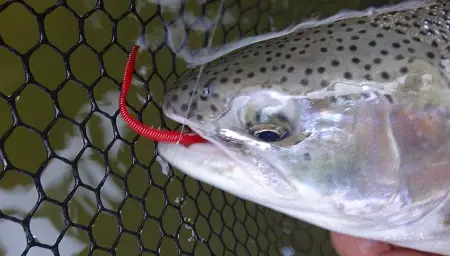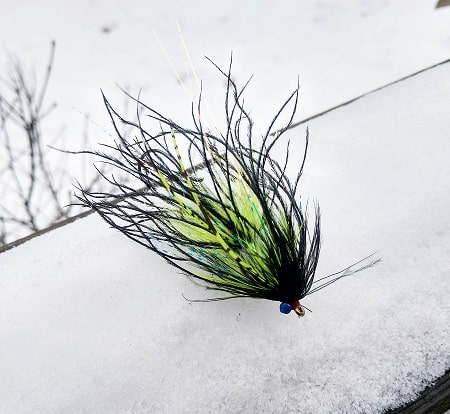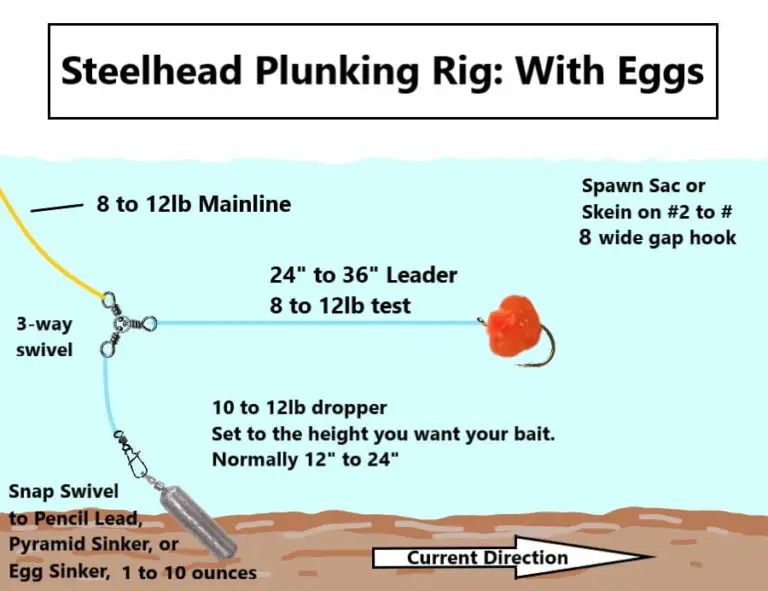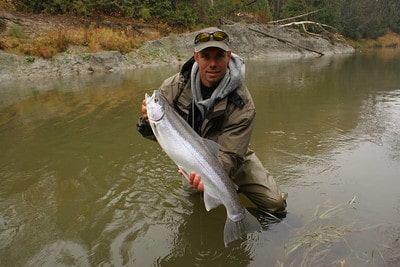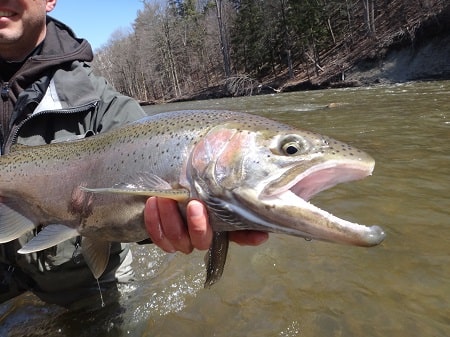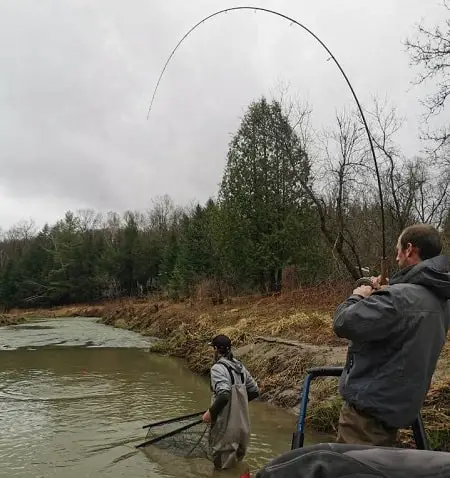15 Guide Tips For Fall Steelhead Fishing In Pennsylvania
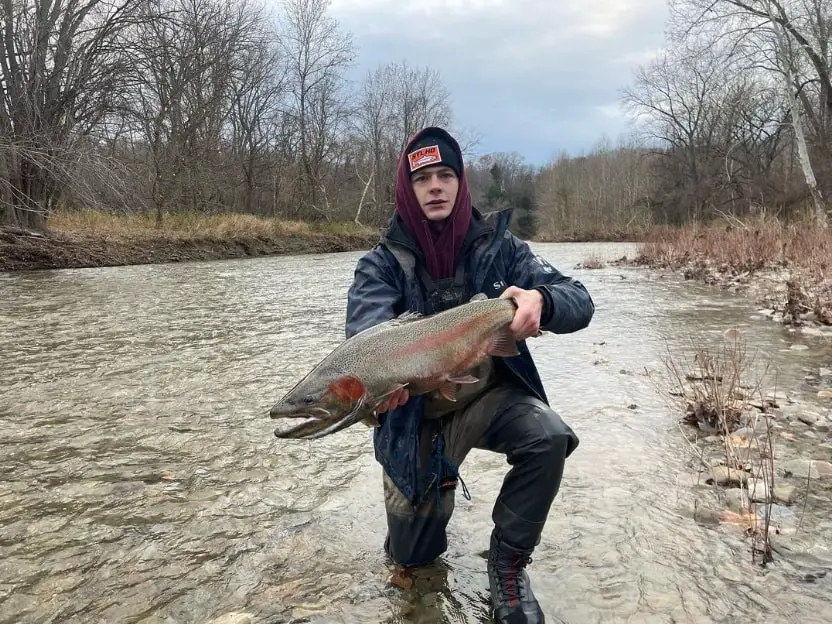
When it comes to fall steelhead fishing in Pennsylvania, anglers should be aware of the hot flies and baits, the best tactics that local steelhead guides use, and they should know about timing the runs and adapting to river conditions.
Pennsylvania’s fall steelhead fishing starts as early as late September and peaks in November and December. The steelhead will enter the rivers after rains raise water levels, and I change baits and flies based on the water clarity and the current speed.
Fall Fishing Steelhead Pennsylvania
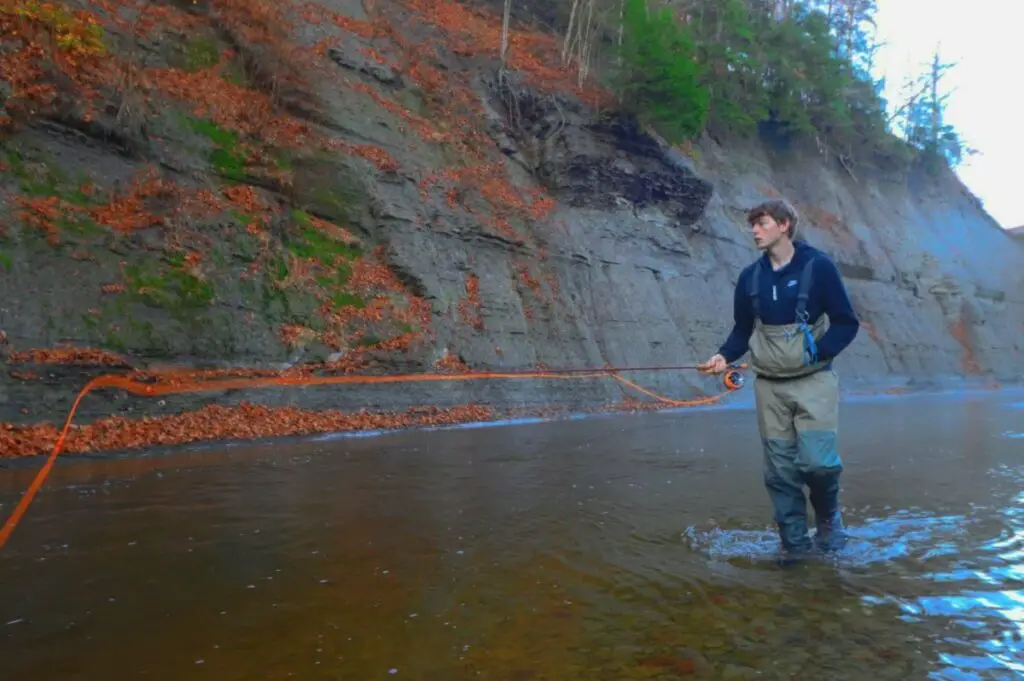
Pennsylvania is a great place for fall steelhead fishing for many reasons, which include huge numbers of steelhead that enter the many small to mid-sized rivers.
The major rivers in the state enjoy good runs of Pennsylvania steelhead thanks to very good stocking programs, which I’ve read can be over a million a year.
With such huge stockings, as the fall months signal the migration of steelhead from Lake Erie into the Pennsylvania tributaries for the purpose of spawning, the steelhead can enter rivers by the thousands and can be concentrated in pools and pockets, making them easy to catch.
Fall steelhead are large and strong and capable of multiple jumps and long drag-screaming runs.
Avoid The Crowds
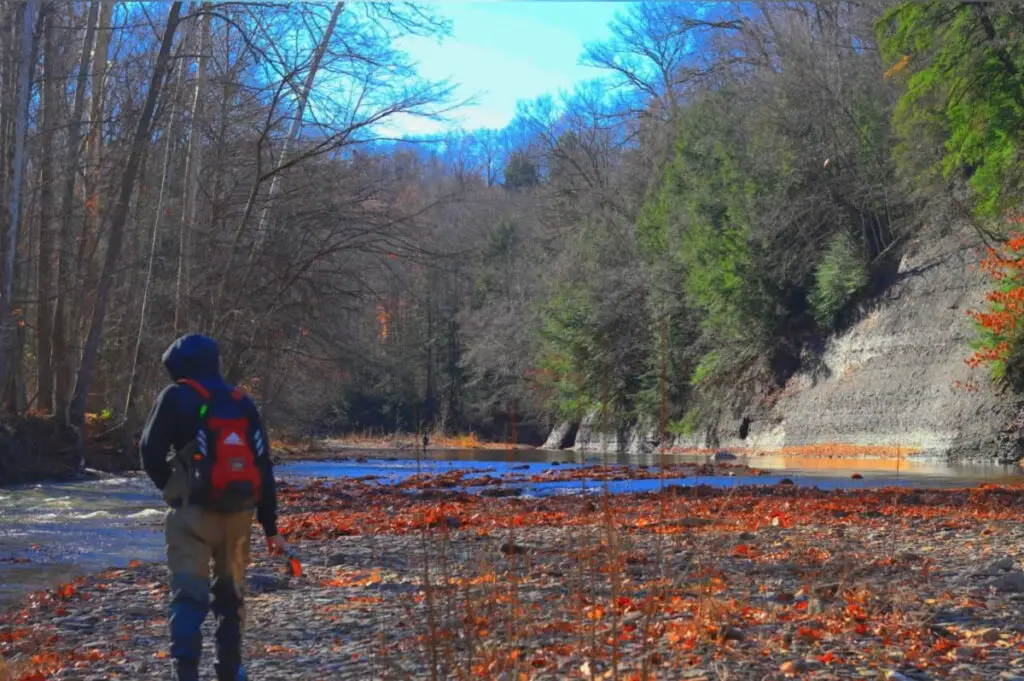
The downside to so many big steelhead entering the river in the fall, and them being pretty easy to catch at times, is that the rivers can get very busy with the banks lined up with anglers.
My tip for crowds, weekends, and for busy times is to:
1. Hike Farther
Go for a long walk far from the access points and bridges to get away from the crowds. Sometimes, I’ll walk 20 minutes before I start to fish, but often, these fish are less pressure and easier to catch.
2. Fish Less Pressured Rivers
Fish smaller, lesser-known, or less busy creeks during the busy times, which are weekends and early mornings. I will sometimes fish the small creeks in the morning and then go to the larger river after 10 am when most of the early morning anglers head home.
3. Choose Your Spot Wisely
During the early fall and or when the steelhead are moving up the river, steelhead will hold in the faster-moving current areas of the tributaries, such as pocket water, chutes, heads of pools, and fast runs. These areas don’t get fished as hard, so they can be more productive than the bigger busy pools.
Pools tend to fish best when the river water levels have dropped very low and halted the steelheads migrations.
4. Fish Hunting Season
Check the local deer hunting season, which is often late November or early December and is when many anglers will hit the forests for a week or two to hunt deer, which means a lot fewer anglers on the river.
Early And Late Fall Steelhead Fishing Pennsylvania
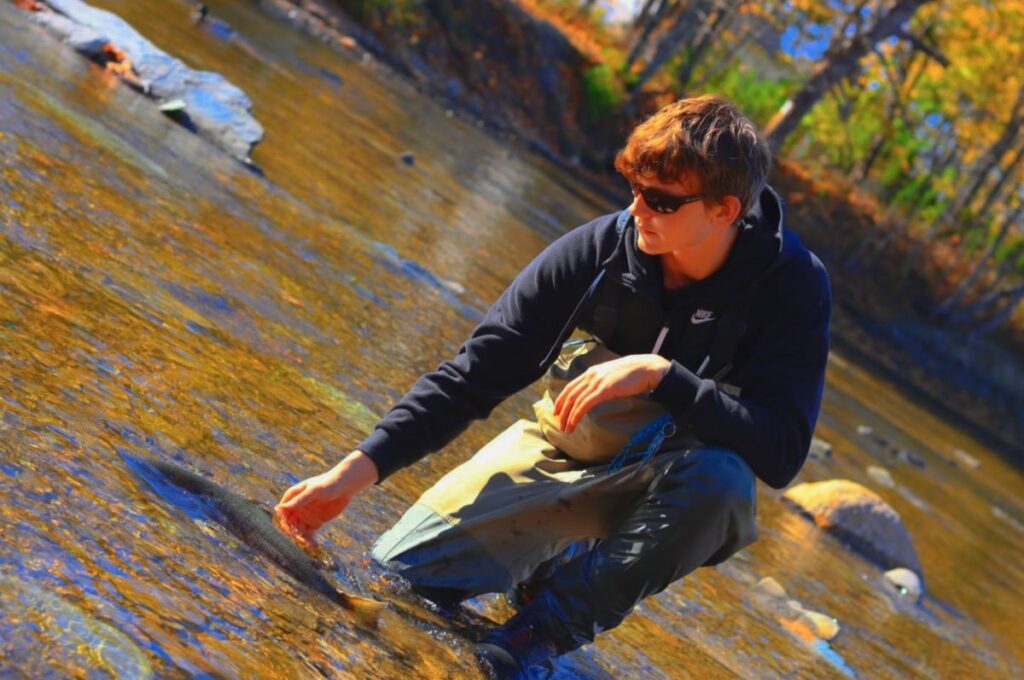
The fall season usually occurs by Mid-September through December, with the shoreline temperatures of Lake Erie dropping to 68F and Pennsylvania steelhead start collecting around the mouths of the Pennsylvania tributaries.
5. River Mouths Can Be Great
Local guides will tell you that even in early September some steelhead will move to the mouth of the river or even into the lower river throughout the night and then move back out to the lake in the morning, giving some anglers opportunities to catch some early fall steelhead at dawn and dusk.
River mouths can be good at any time. Even during the runs, the lower river will have some of the freshest and brightest silver steelhead that fight harder than steelhead that are far up the river.
Strong inshore winds can trigger runs, but mornings after significant rains can be the best time to be at the river mouths.
6. Fish The Rains
Typical of any fall season, the weather gradually gets cooler, and it’s the big rains of early fall that start the runs of steelhead. A heavy cold rain in mid to late September can bring in some steelhead.
More rains in early to mid-October will bring in more fish, and the peak time for fall fishing steelhead is one to three days after significant rains in late October to early December.
With the right techniques and tactics is certain to land a great steelhead catch with the right steelhead fishing techniques.
As these steelhead enter Pennsylvania tributaries, and even though they do not actively feed as they did in the depths of Lake Erie, they will grab a well presented bait or lures they come in contact with.
6. Fish The Drop
I have found that rising water levels are not as good as dropping water levels. Muddy water is also bad for fishing. I adapt and fish different rivers at different times.
After heavy rains, some rivers, especially the larger rivers, will get high and muddy, and they can stay like this for two or three days. This is when I go fish the smaller creeks that clear faster. Smaller creeks also concentrate the steelhead more, so catching them in off-colored water is easier.
During the first 12 to 24 hours after a rain, anglers should focus on the lower river or fish smaller creeks that clear faster. When those rivers become too clear, move to larger rivers that are just clearing or move further up the river and follow the fish.
As high water starts to drop and clear up, “Prime conditions” will occur when the water develops a slightly opaque green tint to it, and this is when the bigger river will fish the best.
Steelhead are very catchable in this type of water green water because the steelhead will be able to see your offering just enough to bite, while still making them feel less vulnerable becuase the water is still higher and not super clear.
Bear in mind that these conditions, depending on the size of the tributary, usually won’t last more than 2-3 days because the run-off rates of most Erie tributaries are very fast.
7. Follow The Fish
I follow the fish to keep my clients catching fish day after day. What this means is that the first few days after a big rain, most steelhead will be in the lower river. But, if we don’t get any rain, five days later, the lower river will have fewer fish, and the upper river will have the most fish.
Early fall and late fall I will also change locations. As fall progresses, stream temperatures will further drop and halt new runs of steelhead, so often, the best fishing is further upstream, especially if it hasn’t rained in a while.
Steelhead runs tend to come to a halt when you start seeing ice along the rivers edges, and this is when they will begin to hold in very slow-moving current areas. This is basically when anglers want to start using winter steelhead tactics.
Check out my page Pennsylvania Winter Steelhead Fishing.
Best Methods For Fall Steelhead
There are a number of fishing methods anglers use in the fall.
Float Fishing For Pennsylvania Fall Steelhead
Floating fishing is one of the most widely used steelhead fishing techniques in Pennsylvania because it’s very effective.
Float fishing is done using spinning reels or centerpin reels, long 9 to 13-foot rods, and a special bobber known as a float.
The concept behind float fishing is you are using a specialized river float attached to the fishing line for the purpose of suspending your bait just off the bottom of the river and allowing it to drift with the current.
8. Tips For More Steelhead When Float Fishing
These are the tips that I teach my clients during float fishing classes and on guide trips.
- Use the right type of float – See Best Floats For Float Fishing
- Have a proper leader setup – See 2 Best Float Fishing Leaders
- Know how to set your float depth, slow your drift, and present your bait effectively.
Float fishing is one of my specialties. If you think float fishing is simply casting out your float and bait and then watching it go, then you will miss a lot of fish. There are certain things I teach my clients that can help them catch ten times more steelheads. See them at Float Fishing For Steelhead – How River Guides Do It.
9. Adjust Your Baits Based On Conditions
Use subtle, more natural patterns and colors in clear water and brighter colors like chartreuse, red, and hot pink in dirtier water.
10 . Hot Baits
Pink and red plastic Berkley or Mad River steelhead worms can be deadly and effective in all types of water conditions, but in clear water, don’t forget to try natural colored plastic worms or live garden worms.
FYI, plastic steelhead worms have accounted for more steelhead in the net for my clients than any other more popular baits.
Fly Fishing For Pennsylvania Fall Steelhead
There is a reason why the majority of steelhead guides in Pennsylvania are fly fishing specialists and only guide with fly rods. Fly fishing is very effective when fall fishing for steelhead in Pennsylvania since the rivers are perfectly suited for this method.
Fly fishing works well in deeper pools, fast runs, pocket water, and in rapids.
I, together with my team, have put together a list of the entire essential fly fishing gear every angler needs for fly fishing on Pennsylvania tributaries. You can check them on my page, Fly Fishing Gear: Everything You Need To Fly Fish.
11. Fly Fishing Tips
Fly fishing for Pennsylvania fall steelhead can be done using a variety of methods depending on your preference. You have nymph fishing, euro nymphing, Spey fishing, and streamer fishing.
- When fishing clear water or pressured fish, go with small flies like 6mm and 7mm egg patterns or size 12 to 14 nymphs.
- In dirty water, go with big egg patterns the size of a nickel or quarter, and use giant dark nymphs up to 1.5 inches.
- Local guides will also use 1 to 3-inch streamers dead drifted or twitched through the spot. Flies like the white zonker can be very hot at times.
12. Try Drift Fishing For Pennsylvania Fall Steelhead
Drift fishing is a great method on faster bigger sections of the river and is a method for catching fall steelhead in Pennsylvania that has been around for a long time.
The Drift Fishing Method: Basically, drift fishing means you tie a snap swivel to your mainline, attach a small weight to the snap, and tie a short one to 2-foot leader with your bait at the bottom. Cast it and allow the setup and bait to bounce along the bottom of the water.
I like drift fish for Pennsylvania fall steelhead because it is effective at getting your bait to the river’s bottom. You should adjust your weight according to the velocity and depth of the flow.
I discuss the best drift fishing tactics, baits, setups, and hooks, and the best types of water suitable for drift fishing on my page Drift Fishing for Steelhead.
13. Try Bottom Bouncing For Fall PA Steelhead
Bottom bouncing is much better on smaller and shallower rivers common in PA. It’s also one of the best methods when fishing pocket water or when the steelhead are holding in shallow water that is too shallow for float fishing.
I use a method called advanced Bottom Bouncing, where the weights are at the bottom for the leader, and the use of a colored line known as a Sighter placed 4 to 7 feet up the line.
With this method and the proper setup, you can keep your bait drifting naturally and just off the bottom for most or all of the drift.
If this method is something you are interested in, check my page, Bottom Bouncing: Traditional and Modern Methods.
Best Baits And Flies For Fall Steelhead Fishing In PA
When it comes to fishing for Pennsylvania fall steelhead, baits are everything.
When the bait is the right bait, you will catch a lot more steelhead, but because the rivers in the fall are often lower and clearer than in the spring, there are baits, sizes, and colors that will work better in the fall.
14. Guide Tips On Baits For Fall PA Steelhead
- Go Big: When fishing the lower river where it’s bigger and faster, the steelhead will be more aggressive, and therefore minnow-type baits and flies, like the white zonker and white Woolly Buggers or worms, can be as effective or better than eggs-type baits.
- When the fish have been in the river for a while or if fishing farther up the river, smaller, more natural baits like single eggs, small spawn sacs, or small flies can be good choices.
- Rotate baits: What this means is to try a bait, and if it doesn’t work, try different sizes, different colors, and different baits before you move to the next spot.
I discuss some of the best baits on my page, Best Baits for Pennsylvania Steelhead.
Flies can be one of the most effective baits and you can use them with all methods, not just fly fishing, you can check out some of the most effective flies that guides have used on my page: 19 Best Flies For Steelhead – An Expert Guides Advice.
15. Know The Rivers
Best PA Rivers For Fall Steelhead Fishing
This is a tough one because while a very popular river might not be a fishing well, a smaller river can be great. This has to do with water flows, water temps, and water clarity.
However, some of the more popular rivers include Racoon Creek, Trout Run, Upper Conneaut Creek, Crooked Creek, Elk Creek, Walnut Creek, Cascade Creek, and Godfrey Run, Twenty Mile Creek, Four Mile Creek, Twelve Mile Creek, Seven Mile Creek, and Sixteen Mile Creek.
For more info on these rivers, see my page Best Steelhead Rivers In PA
Don’t forget that it’s not a far drive from Ohio and New York Steelhead rivers, which could be fishing better. The area from Western NY to Ohio is known as Steelhead Alley. Check out Steelhead Alley: Fishing Tips and Rivers
7 Bonus Guide Tips For Fall Steelhead Fishing Pennsylvania
- Tread lightly: When fishing the super clear rivers of Pennsylvania, approach the pool from the bottom and move slowly so you don’t spook the fish. If you can stay out of the river, that is often best.
- Start Small and Rotate Baits: In small pools or very clear water, I will often start with smaller and less intrusive baits and then go up a size or two if it doesn’t work. Guides will rotate through their baits daily to figure out what baits, colors, or sizes are best based on the daily or sometimes hourly conditions.
- Don’t Leave Fish For Fish: I will stay in the same spot for hours if I know the fish are there. I know guys will say move from spot to spot, but my opinion is that if the spot you are in has fish, but the fish aren’t biting, then they aren’t biting anywhere.
- Be Patient: Sometimes, steelhead will spook as you enter a spot or as another angler leaves, but if you stand quietly and don’t move around, after a while, which could be 10 to 30 minutes, those spooked steelhead might start feeding again.
Adjust To Temperatures
I don’t know how many times I’ve shown up to the river and said to my clients that the steelhead won’t bite until 10am or they will stop biting around 4 pm time, and I have been right most of the time!
I know this because in the fall, I’m on the water guiding for steelhead sometimes 50+ days straight and from September to late December. I’ve done this for over 20 years, and therefore I get to see how the fish react to certain conditions every day.
On mild nights, the fish will often be active early in the day, so be there early, and if it’s a bright sunny day, the chances are they will stop feeding by noon.
On cold nights when the water temps drop a lot and quickly, the fish will be lethargic and inactive, they do not like fast-dropping water temps, and it either takes waiting until they acclimatize to stable water temps or a slight water temperature increase before they become active again.
Therefore, waiting for 2 to 3 hours after sunrise for the sun to warm up the river 1 or 2 degrees is best, and on some days, this means they will be active at 10 am, instead of 7 am.
I don’t know how many times I’ve shown up to the river between 10 am and 11 am, and all the guys are leaving saying the fishing is crap, and then, I go catch a ton of steelhead between 11 am and 2 pm, and I’m there by myself.
Guys, early morning is not always the best!
Guide Tip: Fishing in slush is rarely productive. Slush usually occurs as water temperature plummets and gets near freezing. Slush also prevents you from getting good drifts as your float, indicator, and bait can get stuck or pulled around by clumps of slush.
For more on just PA Steelhead fishing, check out Fishing For PA Steelhead.
Make sure you know the Pennsylvania fishing regulations and have a valid fishing licence.
Tight Lines,
Graham

